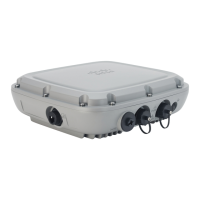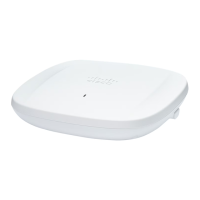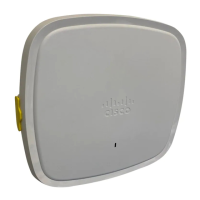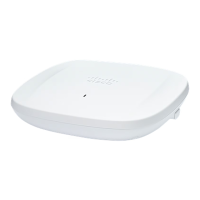13
Cisco Catalyst 9120AX Series Access Points
10 Powering the Access Point
The AP can be powered only through Power-over-Ethernet (PoE) using the following:
802.3at (PoE+): Any 802.3at (30.0 W) compliant switch port or Cisco Power Injector AIR-PWRINJ6=
802.3af: Any 802.3af (15.4 W) compliant switch port or Cisco Power Injector AIR-PWRINJ5=
Note If 802.3af is used, both the 2.4 GHz and 5 GHz radios will be reduced to 1x1 and Ethernet will be
downgraded to 1 GbE. The USB port will also be off.
11 Configuring and Deploying the Access Point
This section describes how to connect the access point to a controller. Because the configuration process takes place
on the controller, see the Cisco Wireless Controller Configuration Guide for additional information.
The Controller Discovery Process
Note • The controller must be running release 8.9.111.0 as it supports 9120AX series access points. For more
information, visit the access point data sheet available on Cisco.com at
https://www.cisco.com/c/en/us/products/collateral/wireless/catalyst-9100ax-access-points/guide-c07-742311.
html.
• You cannot edit or query any access point using the controller CLI if the name of the access point contains
a space.
• Make sure that the controller is set to the current time. If the controller is set to a time that has already
occurred, the access point might not join the controller because its certificate may not be valid for that
time.
Access points must be discovered by a controller before they can become an active part of the network. The access
point supports these controller discovery processes:
Locally stored controller IP address discovery—If the access point was previously joined to a controller, the IP
addresses of the primary, secondary, and tertiary controllers are stored in the access point non-volatile memory. This
process of storing controller IP addresses on an access point for later deployment is called priming the access point.
For more information about priming, see the “Performing a Pre-Installation Configuration” section on page 10.
DHCP server discovery—This feature uses DHCP option 43 to provide controller IP addresses to the access points.
Cisco switches support a DHCP server option that is typically used for this capability. For more information about
DHCP option 43, see the “Configuring DHCP Option 43” section on page 17.
DNS discovery—The access point can discover controllers through your domain name server (DNS). For the access
point to do so, you must configure your DNS to return controller IP addresses in response to
CISCO-CAPWAP-CONTROLLER.localdomain, where localdomain is the access point domain name. Configuring the
CISCO-CAPWAP-CONTROLLER provides backwards compatibility in an existing customer deployment. When an
access point receives an IP address and DNS information from a DHCP server, it contacts the DNS to resolve
CISCO-CAPWAP-CONTROLLER.localdomain. When the DNS sends a list of controller IP addresses, the access
point sends discovery requests to the controllers.
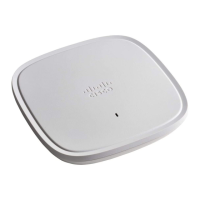
